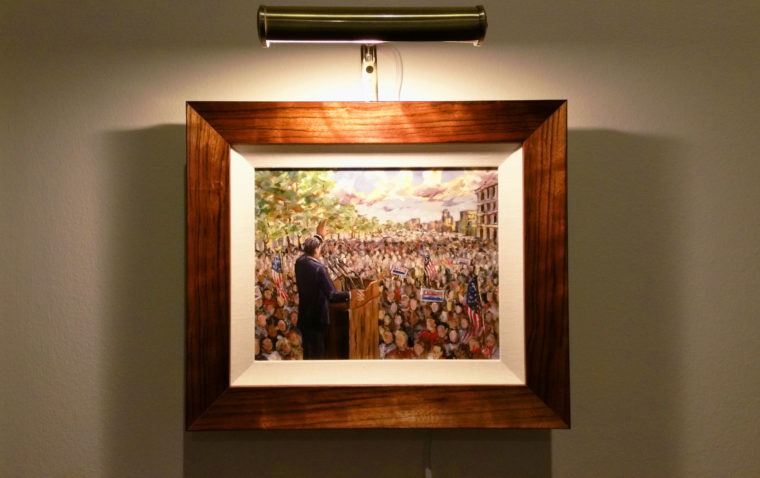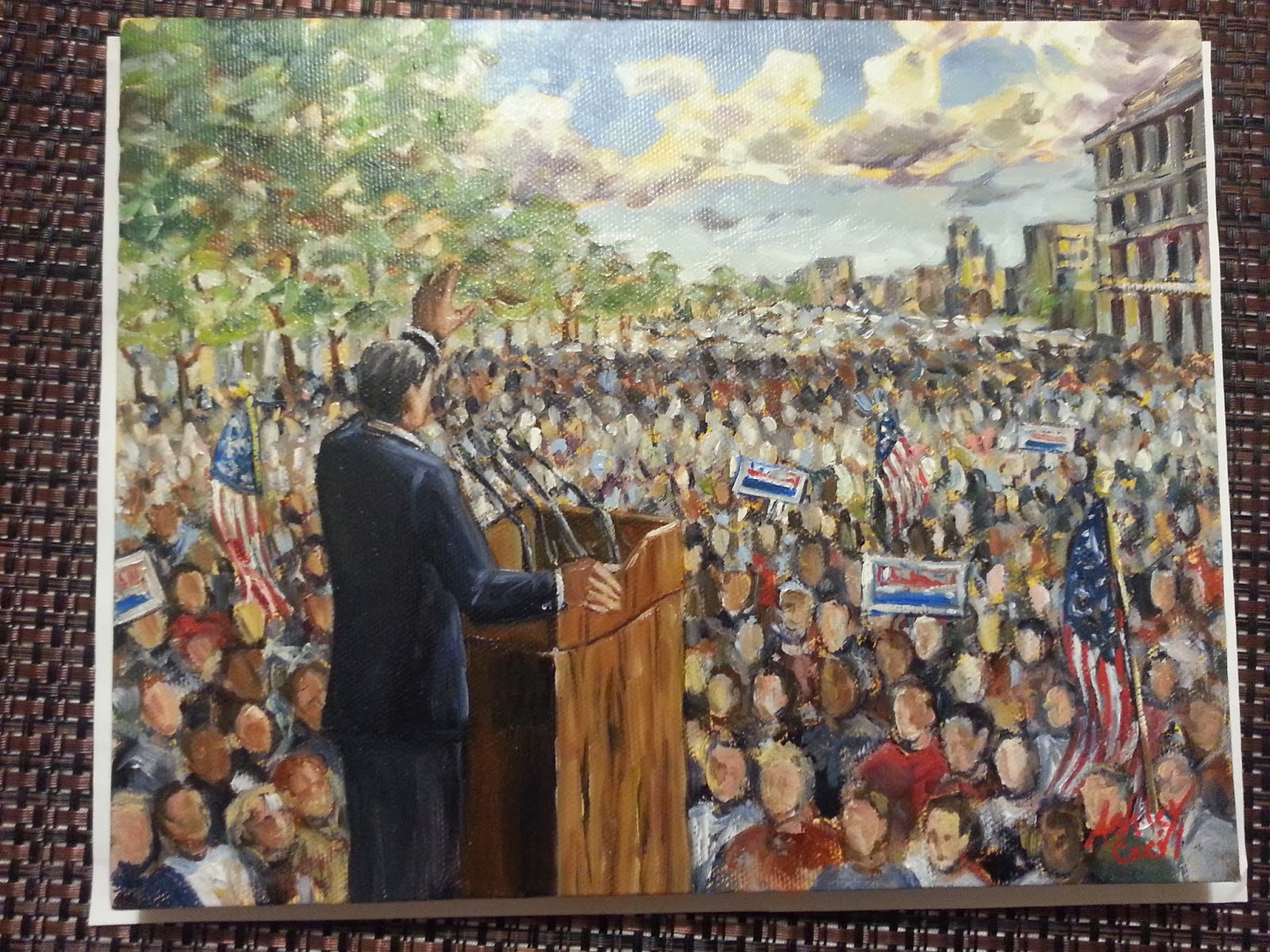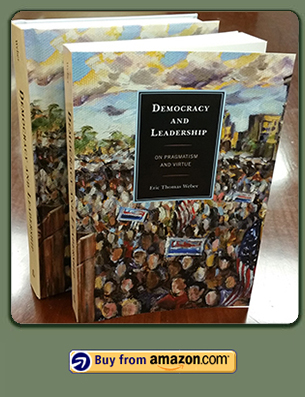This past week, I finally hung a light that I got as a gift last year over my favorite painting. The story is worth sharing, I believe, because it has to do with my most rewarding benefit I’ve received from social media activity as a scholar. Another reason it is personally meaningful is that it marks the conclusion of a promise I made.
In late 2013, my book, Democracy and Leadership, was published. I had looked far and wide for the right image for the cover. My first publisher put out my first two books without giving me a choice about the cover. So, while I appreciate that one shouldn’t judge a book by it’s cover, I’ve heard enough people do it to be eager for a say in its design. I wanted to find just the right image to capture what I’m up to in the book. I’d hoped it could be a pretty painting somehow, featuring a context for leadership, but somehow highlighting the people more than the politician.

I was delighted when Ashley permitted me to use the image on the cover of the book. Of course, I had only seen a high quality photo of the painting online. She had sold the painting a few years back. That said, I spread the word about the book a bit online, and per our agreement, I sent Ashley a copy of it. When she got it, Ashley put a post on her Web site about the book, as not every artist has his or her work on a book cover.
Social media offers us powerful tools. People who love Ashley’s work, as I do, follow her blog, and one collector saw the post where she announced that her painting was now cover art. The collector who bought that painting years ago saw her post. Kentucky attorney John Rogers contacted me, I believe via Twitter. He showed me a photo of the painting and said that he thought I should have it. I told him I’d obviously send him a copy of the book. All he asked was that I share with him a picture of the painting once I’d gotten it up on the wall. True story. It continues to mean a lot to me, every time I see it, in fact.
People can be very cynical about humanity sometimes, what with the news we hear about politics & violence. We sometimes call happy stories “puff” pieces, with little substance and thus little meaning. I think that this story resists that label for two reasons. The first is that while there are costs and reasons to worry about some elements of social media, it is easy to overlook how they can connect people with kindness and goodwill across distance. It helps to know that not everyone is a “troll” or a credit card predator. The second reason is that as a scholar who’s trying in modest ways to put work out there, to let people know what I’m doing, I’m so glad to know that some people see it and are encouraging.
Once again, I can’t thank you enough, John. The painting means a lot, and so does your kindness and encouragement.
On my old blog, which I’m putting out to pasture now that I have my new designed, I had written about this story, calling it “‘My Coolest Internet Experience,’ or ‘People Can Be Remarkably Kind’.” Here’s the content of that post:
‘My Coolest Internet Experience,’ or ‘People Can Be Remarkably Kind’
Saturday, February 15, 2014
I’ve always been somewhat optimistic. There are limits to what we can control, which we need to be stoic about, but positive thinking makes a difference within those limits. When we see daily reports about crimes or read books and watch television shows about crooks and drug dealers, it’s no surprise that some folks come to feel cynical about people. I’m happy to report that this week I’ve had my coolest Internet experience ever, which confirmed my feeling that people can be profoundly kind.
With all of the silly and crazy Internet tools we have available (see the absurd variety hereabove), we can spend a lot of time spreading the word about issues we care about or projects we’re working on, while none of our individual tweets or posts seem to be particularly effectual. I’ll write about the several interesting opportunities and connections I’ve made through these channels in some other post, but I have to say something here about an amazing experience I’ve had this week.
My 2013 book, Democracy and Leadership: On Pragmatism and Virtue, came out with a publisher that permitted me to pick and design the cover, from a few possible form templates. The talented Ashley Cecil‘s beautiful painting is on the cover, as you may already know (it’s on right here). To spread the word about the book, I posted on these various Internet channels, including on a new Facebook Author page — why not?
I have friends with nearly 1,000 “likes” on their author pages, which is great. It’s a way of reaching lots of friends and interested audiences when you’ve got something you feel needs to be said. My own page today has a modest 247 “likes,” but I’m just getting started.
As I was spreading the word about the release of the book and creating the Facebook page, Ashley Cecil posted an announcement about the release of the book on her Web site. Some of Ashley’s fans and art collectors connected with my Facebook page. That’s how I came into contact with John Rogers, an attorney and art collector from Glasgow, Kentucky. It turns out that John was the art collector who had bought Ashley’s painting.
Obviously John and I have sympathetic taste, because when I was looking for cover art — and I searched quite a bit — I knew instantly that this was the painting I wanted for the cover, if I could make it work out. John asked me how I had come across the painting. Though I had looked through various databases of art (paintings and photographs), starting with works in the public domain, I eventually stumbled across Ashley’s painting by wading deep through search term results that I found on Images.Google.com.
While it’s fun to connect with an art collector with sympathetic taste, the story gets better. John wrote me (via Facebook message) to say that he thought that I should have the painting.
I couldn’t believe it.
Art collectors sometimes invest in works that they hope to sell later for a profit. For me, the painting has great sentimental value, because it’s the beautiful first artwork that I’ve been able to select for a book cover. In addition, the book was 4 years in the making and was a lot of hard work, so the artwork is seriously meaningful to me.
At the same time, my university has granted me a sabbatical to write my next book. You can either accept full-pay for one semester, or you can take the same funds divided over the course of a full year. More than a year ago, I discussed this with my wonderful wife Annie (yesterday was Valentine’s Day, I should note), and she agreed that time is the hardest thing to come by. So, we trimmed expenses, saved up for about a year, and now we’ve made it so that I can take this full year to write. It also means that I can’t get into art collection… Certainly not for a while, anyway.
I didn’t see John’s generosity coming. And remember, I’m one of the optimists out there.
Three days after John’s message, the painting arrived — on Valentine’s Day, no less. Here it is on our kitchen table:
The painting is 8″ by 10″ and is going to go up in my office at work. It is not only the artwork that an artist first gave me permission to use on a book cover. It is also the first such work that I also now own. I’m still somewhat in disbelief about John’s magnanimity. I believe that people are largely very good and sympathetic with others when not conditioned otherwise in some way. That doesn’t capture just how friendly and giving people can be, though.
Therefore, this blogpost — and a copy of Democracy and Leadership soon to be in the mail — is dedicated to John Rogers of Glasgow, Kentucky, for showing me just how remarkably kind people can be, especially to a stranger several states away. Thank you so much, John, for your generous gift, and thanks to Ashley for creating this piece and allowing me to use it for the book.
I can’t thank you enough, John.







 About Me
About Me